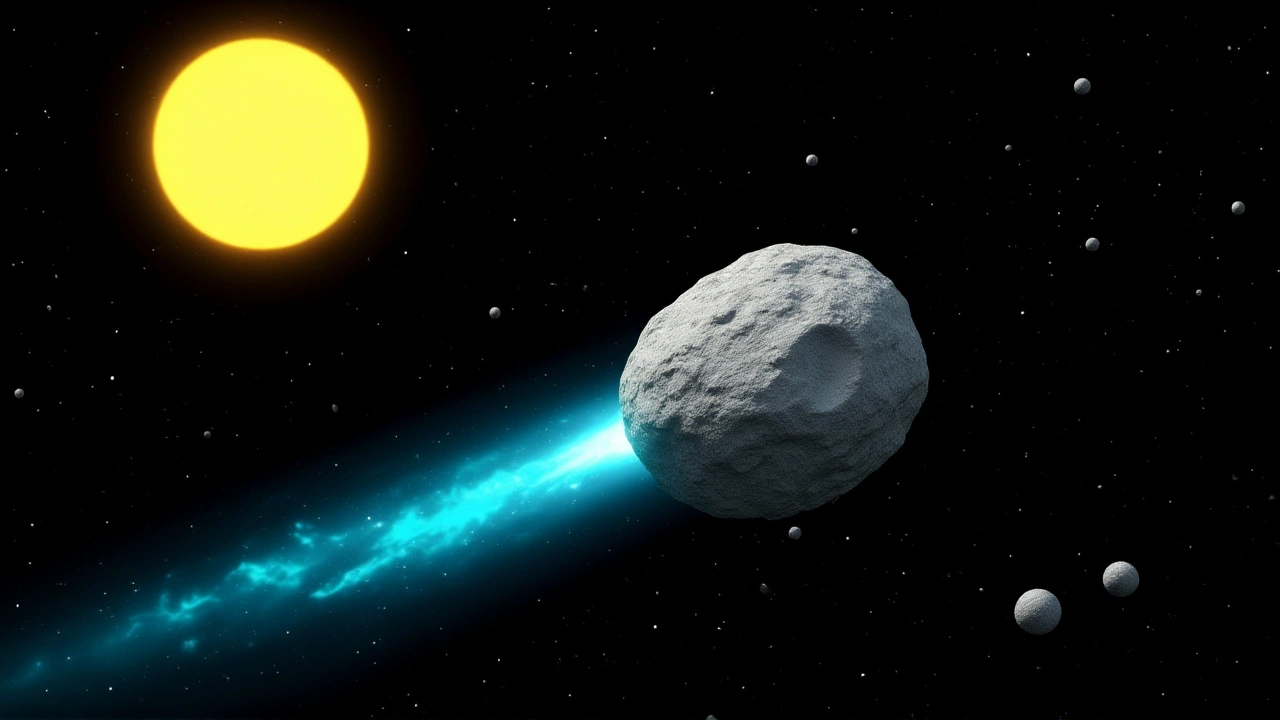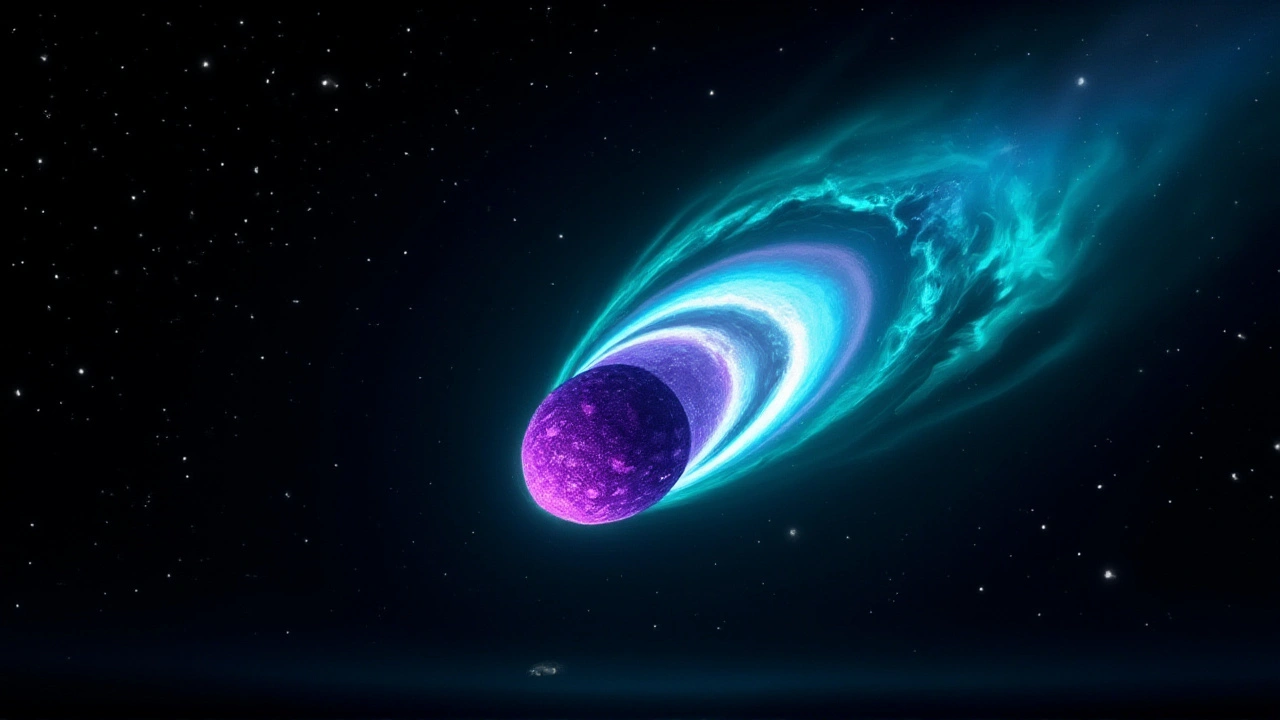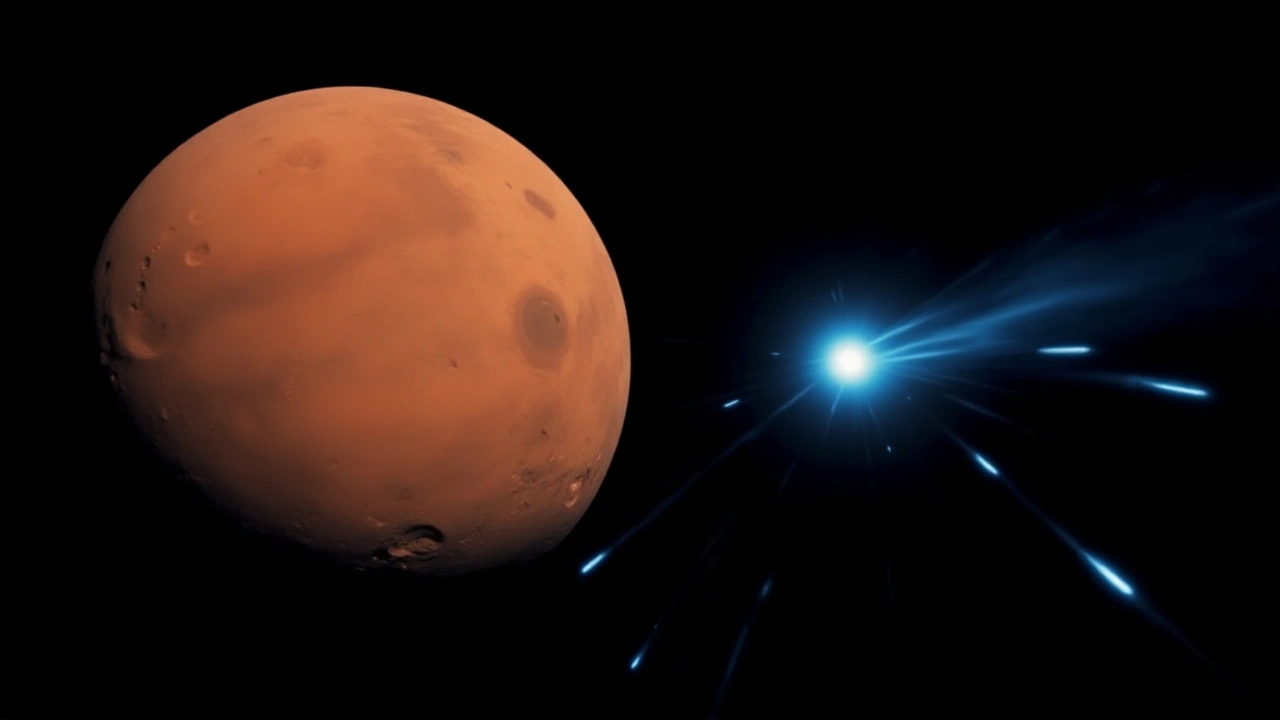When NASA scientists watched the Mars flyby of 3I/ATLASMars on October 3, 2025, the interstellar comet brushed past the Red Planet at roughly 28 million kilometres. The event marked only the third confirmed visitor from beyond our solar system, yet the excitement was muted because a U.S. government shutdown had already shut down most NASA public data portals. Astronomers scrambled for real‑time telemetry while the agency’s websites displayed the familiar gray ‘temporarily unavailable’ banner.
Historical Context: A Growing Family of Interstellar Objects
Before 3I/ATLAS, only two interstellar interlopers had been catalogued: ‘Oumuamua in 2017 and comet 2I/Borisov in 2019. Both sparked intense debate about their origins, composition, and even the possibility of alien technology. The discovery of a third such object re‑ignites those questions, but this time the scientific community is better prepared, thanks to a network of survey telescopes and archival data mining that didn’t exist a decade ago.
Observation Campaign and Data Sources
The first glimpse of 3I/ATLAS arrived from the ATLAS (Asteroid Terrestrial‑impact Last Alert System) telescope stationed in Rio Hurtado, Chile on July 1, 2025. The discovery was promptly reported to the Minor Planet Center, which assigned the provisional designation 3I/ATLAS. Shortly after, researchers combed through image archives from three other ATLAS units worldwide and from Caltech’s Zwicky Transient Facility at Palomar Observatory, extending the comet’s recorded trajectory back to June 14, 2025.
Dr. Laura Hernandez, a planetary scientist at the California Institute of Technology, explained, “Those pre‑covery images were a game‑changer. They let us tighten the orbital solution before the comet even reached the inner solar system.” The team’s refined hyperbolic orbit confirmed that the object is not bound to the Sun and entered from interstellar space, travelling at a pre‑encounter velocity of about 32 km s⁻¹ relative to the Sun.
Impact of the Government Shutdown on Research
America’s longest‑running shutdown in modern history began on September 30, 2025, and immediately knocked out many public‑access servers. For astronomers accustomed to pulling ephemerides, spectral data, and real‑time alerts from NASA’s Near‑Earth Object (NEO) program, the blackout felt like losing a lifeline during a heart‑monitor test. “We were literally looking at the comet and the screen just went blank,” said amateur observer Stefan Burns, who live‑tweets from his backyard observatory. “It’s ironic that the most exciting celestial event of the year happens while we’re cut off.”
Some researchers turned to private data pipelines and hosted versions of the Minor Planet Center’s database, but latency rose to several minutes, hampering rapid response observations. The shutdown also delayed the release of high‑resolution spectra from the Hubble Space Telescope, which was slated for October 5, 2025, potentially missing critical outgassing signatures.

Scientific Significance and Emerging Theories
Cometary activity surges when ices sublimate near the Sun, creating bright tails that reveal composition. Early photometric data suggest that 3I/ATLAS is unusually active for its size, brightening by more than two magnitudes between July and September. If spectroscopic follow‑up confirms the presence of exotic volatiles—say, molecular oxygen or methanol at atypical ratios—it could point to a formation environment unlike any known in the Solar System.
Speculation runs wild on internet forums. While a minority postulate that the comet could be an alien probe, the consensus among professional astronomers remains grounded: “There’s no evidence of artificial signatures. The data fit a naturally occurring comet,” said Dr. Mei‑Lin Kuo of the Jet Propulsion Laboratory.
- Closest approach to Mars: ~28 million km (0.19 AU) on 2025‑10‑03
- Perihelion (closest to Sun): 1.4 AU on 2025‑10‑30
- Minimum distance to Earth: 1.6 AU (≈240 million km)
- Estimated nucleus size: 0.5‑1 km based on brightness
- Hyperbolic excess speed: ~32 km s⁻¹
Future Trajectory and Observation Opportunities
After slipping past Mars, the comet will swing outward, heading toward the outer Solar System at a speed that will carry it beyond Pluto in roughly 12,000 years. Its outbound leg offers a narrow window for ground‑based observatories in the Southern Hemisphere to capture near‑infrared spectra before it fades below magnitude 22.
Space‑based assets such as the James Webb Space Telescope (JWST) have filed Target of Opportunity requests, pending the shutdown’s resolution. If approved, JWST could probe the comet’s dust grain size distribution and search for complex organics, delivering a chemical fingerprint of its birth star system.

What Comes Next: Funding, Data, and Public Interest
The shutdown is slated to end when Congress passes a funding bill, a date currently open‑ended. In the meantime, citizen scientists are stepping up, uploading raw images to the Open Astronomical Data Archive. Their contributions could fill gaps left by the official pipelines.
Beyond the immediate science, 3I/ATLAS has sparked a wave of educational outreach. Schools across the United States have organized “Comet Watch” nights, using inexpensive telescopes to teach students about orbital dynamics and the rarity of interstellar visits.
Frequently Asked Questions
How does 3I/ATLAS affect astronomers studying interstellar material?
The comet provides a fresh sample of material that formed around another star, letting researchers compare its composition with that of comets from our own system. Early spectra hint at unusual volatile ratios, which could reshape models of planet formation beyond the Solar System.
Why was NASA’s data unavailable during the flyby?
A federal budget impasse led to a government shutdown on September 30, 2025, causing most public‑facing NASA servers, including NEO data feeds, to go offline. The shutdown impacted real‑time alerts and delayed the release of high‑resolution observations.
Is there any risk that 3I/ATLAS could collide with Earth?
No. Orbital calculations show a minimum approach distance of 1.6 AU, roughly 240 million km, keeping the comet well outside any impact corridor. NASA’s monitoring confirms it will continue on a hyperbolic escape trajectory.
What are the next steps for scientists once the shutdown ends?
Researchers plan to resume full‑scale data analysis, upload pending observations to public archives, and pursue Target of Opportunity proposals with JWST and other space telescopes. The goal is to lock in the comet’s chemical signature before it fades beyond detection.
How does 3I/ATLAS compare to the previous interstellar visitors?
Unlike ‘Oumuamua, which showed no cometary activity, and Borisov, which behaved like a typical icy comet, 3I/ATLAS appears unusually active at a relatively large heliocentric distance. Its speed and trajectory also differ, offering a new data point on the diversity of interstellar bodies.







Posts Comments
Jared Mulconry October 7, 2025 AT 23:48
What a shame the shutdown stole the spotlight from the comet.
Brandon Rosso October 10, 2025 AT 07:21
Even though the servers went dark, the community rallied like never before. Many of us set up private pipelines to keep the data flowing, and the collaboration spirit has been inspiring. It reminds me that science thrives on resilience, not on bureaucratic uptime. The comet’s observations are still coming in, albeit a bit slower, and that’s something to celebrate.
Tracee Dunblazier October 12, 2025 AT 14:54
While the enthusiasm is commendable, the lack of official data hampers rigorous analysis. Without calibrated spectra from NASA, we’re left piecing together fragments that may miss crucial signatures. A more structured backup system would prevent this recurring bottleneck.
Edward Garza October 14, 2025 AT 22:28
Honestly, the whole hype about an interstellar visitor feels overrated when you can’t even get the raw numbers. It’s just another rock passing by, nothing more.
Allen Rodi October 17, 2025 AT 06:01
I get where you’re coming from, but think about the unique chemistry we might uncover. Even a “rock” from another star can teach us about planetary formation beyond our system, so it’s worth the extra effort.
Jody Webster October 19, 2025 AT 13:34
Wow-so many “experts” are suddenly experts, huh??, but the data blackout really shows who’s genuinely interested and who’s just chasing clicks,, isn’t it??
Steve Goodger October 21, 2025 AT 21:08
The interstellar comet 3I/ATLAS offers a rare laboratory for comparative planetology, and its passage near Mars provides a unique geometric perspective.
By extending the observational arc back to mid‑June, astronomers have dramatically reduced orbital uncertainties, which is a triumph of modern sky survey networks.
The pre‑encounter hyperbolic excess speed of roughly 32 km s⁻¹ indicates that the object arrived from a region of the galaxy with relatively low stellar velocity dispersion, perhaps a nearby star‑forming association.
Photometric data suggesting a two‑magnitude brightening between July and September point to an unusually active nucleus for its size, implying abundant volatile reservoirs near the surface.
If future spectroscopy confirms elevated ratios of molecular oxygen or methanol, we may have to revise models of icy body formation in protoplanetary disks.
The shutdown of NASA’s public data portals, while inconvenient, has also highlighted the importance of distributed data stewardship among the global astronomy community.
Amateur observers, who often operate under less restrictive data policies, have stepped in to fill gaps, demonstrating the democratization of transient astronomy.
The citizen‑science uploads to open archives will likely become valuable calibration points for later analyses, especially when dealing with faint, high‑signal‑to‑noise spectra.
From a dynamical standpoint, the comet’s perihelion at 1.4 AU ensures it will experience solar heating sufficient to sublimate a range of ices, which can be traced via near‑infrared spectroscopy.
The upcoming JWST Target‑of‑Opportunity request, if granted, could resolve grain size distributions down to sub‑micron scales, offering clues about the dust processing history of its parent system.
Moreover, detecting complex organics such as amino‑acid precursors would directly inform the universality of prebiotic chemistry across the galaxy.
The fact that the comet will exit the Solar System and not return means we have a single, fleeting chance to sample its material, underscoring the urgency of coordinated observations.
Funding uncertainties notwithstanding, the scientific return from 3I/ATLAS could be comparable to the most groundbreaking interstellar discoveries of the past decade.
Educators leveraging “Comet Watch” nights are also planting seeds for the next generation of explorers, which is an often‑overlooked benefit of such events.
In summary, despite bureaucratic setbacks, the community’s adaptive response illustrates both resilience and the collaborative spirit that drives modern astrophysics.
We should therefore celebrate the data we do have and continue to push for open, redundant pipelines so future interstellar visitors are not lost to administrative hiccups.
johnson ndiritu October 24, 2025 AT 04:41
👍 Absolutely love the thorough breakdown! 🚀 Let’s keep the data flowing and the community hype alive. 🌟
sheri macbeth October 26, 2025 AT 12:14
Sure, NASA’s shutdown is just a coincidence – maybe the comet was sent to warn us about the deep state’s secret space program.
Lane Herron October 28, 2025 AT 19:48
Behold, the celestial interloper-an astronomical deus ex machina that shatters our epistemic comfort zones and forces a radical re‑evaluation of panspermia hypotheses.
Henry Cohen October 31, 2025 AT 03:21
Actually, the spectral signatures we’ve seen so far don’t support any exotic panspermia scenario; they align with known carbon‑rich volatiles.
Mark Langdon November 2, 2025 AT 10:54
It’s tough seeing the data pipeline go dark, but the way everyone’s pitched in shows how tight this community really is.
Ciara Russell-Baker November 4, 2025 AT 18:28
i cant beleive some peopel think this is just another rock - its a whole new chance to learn bout other star systems.
Aaron Samarita November 7, 2025 AT 02:01
The comet is interesting, but let’s not pretend it will revolutionize everything; we’ll need more data before drawing big conclusions.
Daisy Pimentel November 9, 2025 AT 09:34
In the grand tapestry of cosmic events, even a modest comet invites us to reflect on our fleeting place in the universe.
Ellen Ross November 11, 2025 AT 17:08
While that’s a poetic view, the real issue is funding-without stable support, future interstellar studies will remain speculative at best.
Fabian Rademacher November 14, 2025 AT 00:41
Honestly, if the shutdown didn’t happen, we’d probably have already spotted a fleet of alien probes hitching a ride on these comets.
Write a comment